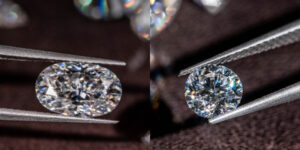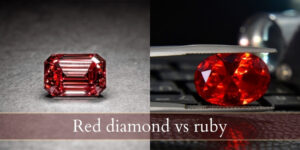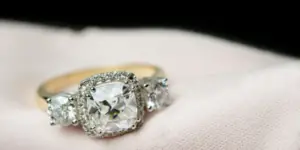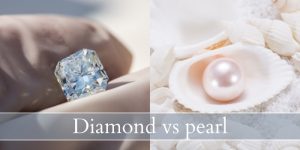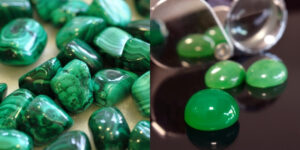Wondering what kind of diamonds to get ? Then you’ve likely heard of colored diamonds but might be unsure just what they are. So let’s take a look at colored diamond, white (colorless) diamond, and see just how they differ. Both diamond types are in high demand so you’re bound find either of these at a jeweler.
Colored vs white diamonds
Colored diamonds tend to be more expensive than white diamonds, and harder to find, but white diamonds sparkle more. The color difference between white diamonds and colored diamonds is sometimes very small, as many natural colored diamonds have a faint color. Lab-grown colored diamonds tend to be the ones with the stronger color, but also much cheaper than natural colored diamonds.
What is a white diamond ?
White diamonds are clear, colorless diamonds with not significant color tint. These are called white diamonds just to make it easier to compare to colored diamonds. White diamonds are the classic diamond most people think of whenever they imagine a diamond ring.
Of course, the ‘white’ in a white diamond can have a bit of a yellow tint, hence the GIA diamond color grading scale going from D to Z, where Z is noticeably yellow, and anything past that is fancy color diamond territory. We’ve explained white vs fancy yellow diamonds here.
What is a colored diamond ?
A colored diamond is any diamond that has a noticeable trace of color, such a yellow, blue, red, pink, purple, pink, orange, grey, brown, and so on. Colored diamonds are actually called fancy color diamonds, to separate them from the traditional white diamonds. There are white colored diamonds, and those have milky white inclusions that make them almost opaque, but they are still chemically diamonds. Those are called fancy white diamonds, but they are not the white diamonds we are comparing the colored diamonds to.
Some of the most common fancy colored diamonds on the market are yellow and blue diamonds. You may also find black diamonds, but there is far less demand for those. Grey diamonds are often confused for salt and pepper diamonds, which are similar but ultimately different.
There’s something you should know about colored diamonds, and that is they’re usually quite pale if they’re natural diamonds. The only colored diamonds that manage to hit a really vivid color naturally are yellow diamonds (due to nitrogen). Any other color, like blue, or red, or green, tend to be very pale.
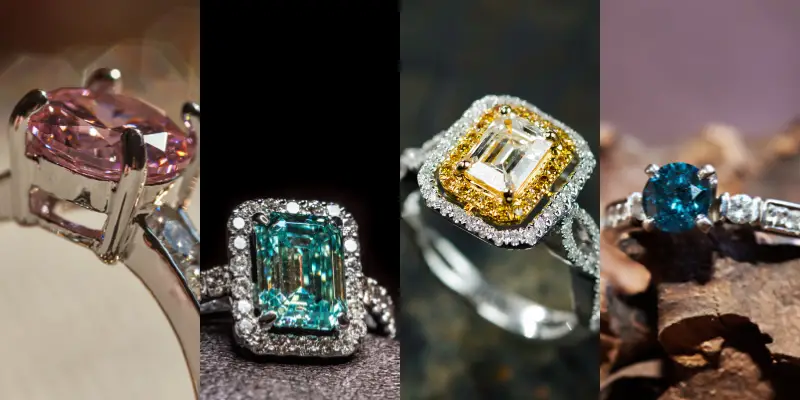
Wondering just how a diamond get its color ? It’s a combination of physics (optics) and chemistry, so here is a quick rundown of the key factors:
- yellow comes from trace amounts of nitrogen, can sometimes lean into brown
- blue comes from trace amounts of boron
- red comes from slight imperfections in the physical crystal, bending the light so it appears red
- black is due to many, many, many inclusions of graphite, another form of carbon
You can get diamond in any combination of these, such as orange (crystal lattice defect+nitrogen), green (nitrogen+boron), very dark blue (boron+a lot of tiny graphite inclusions), purple (boron+crystal lattice defect, and possibly a bit of graphite for a darker color). These are just a few examples but you get the overall idea.
So, now we know what a white diamond is, what a fancy color diamond is, so it’s time to compare the two categories so you have a better idea of what sets them apart.
White diamonds are much easier to find than colored diamonds
If you’re not very particular about color, but want to get your diamond very soon, then a white diamond is a better option. Many jewelers carry some colored diamonds as well, but not all of them. And if you want a specific color or shade of color, they may or may not have it. But they do have white diamonds on stock, at all times, and with varying specs (cut, color, clarity, carat).
If you don’t mind waiting around a few weeks for a colored diamond selection, or you don’t mind going to a very specific place for a specific diamond, then colored diamonds will be just right. Still, there is the issue of the exact color and shade, just like choosing the right pain for the living room.
Read also: What Are Fancy Diamonds ?
Colored diamonds tend to be more expensive than white diamonds
Why are colored diamonds more expensive ? Because they’re rarer and harder to find than white diamonds, and this is a big factor for any diamond’s price (scarcity). Add to this the fact that people expect diamonds to be white in the first place, and you’ve also got the fascination that comes with looking at a blue diamond (or yellow, pink, green, what have you).
An interesting note about fancy colored diamonds: clarity doesn’t matter as much here as it does for white diamonds. Here clarity is only meant to be eye-clean, regardless of the diamond’s actual clarity grade. So an vivid yellow SI2 that is somehow eye-clean will be priced very similarly to an eye-clean VVS1, for example. So when it comes to clarity in colored diamonds, don’t fret too much.
So for example a 1 carat white diamond, H color, VS1 clarity, can sell for anywhere between $4,000-$6,500 for any cut style other than round brilliant. Rounds with this spec can sell for around $8,000-11,000 depending on where you buy them and the quality of their cut.
Meanwhile a fancy colored diamond can sell for far more, such as 10 times more than a white diamond. Yellow diamonds are the most common and are lower priced than blue and red diamonds which can get to astronomical prices.
Lab-grown colored diamonds are worth just as much as white lab-grown diamonds
It might sound counterintuitive but there it is. If it’s lab-grown, it doesn’t matter that much if the diamond is white, red, pink, or yellow. The price goes down significantly. For white diamonds the lab-grown ones look the same as the natural ones, but for fancy colored diamonds there is a big difference.
Lab-grown colored diamonds are able to achieve a very, very strong color. The only fancy color diamonds that hit an intense color are yellow diamonds, the rest are very pale or very dark, like blue or pink or green. But lab-grown colored diamonds will come in any color and intensity you ask, because the color can be influenced as the diamond grows.
So, while a Fancy Light blue 1.5 carat natural diamond can go for $200,000 (!!), a lab-grown Fancy Intense blue will sell for a measly $4,000. You can use this to your advantage though. If you’re set on a colored diamond and your budget doesn’t allow you too much room, you can opt for a lab-grown one instead.
White diamonds tend to sparkle a bit more than colored diamonds
Does the sparkle of a diamond matter to you ? If it does then a white diamond is going to please you more, because it has a much better chance of sparkling just like you want it to. A diamond’s sparkle is mostly affected by the quality if its cut (facet alignment, facet polish, symmetry, open/closed culet, girdle thickness, etc) but color and clarity are part of the equation as well.
The less color there is in a diamond, the better you will be able to see the brilliance (white light) and the fire (rainbow light) of the diamond. The more color there is in a diamond, the amount of brilliance and fire is slightly reduced, and the brilliance will take on the diamond’s body color (so will appear blue, red, yellow, green, or whatever color the diamond has). The diamond’s body color will also dull the fire as well.
Clarity is also an issue because it interrupts light directly, and results in less light being reflected from facet to facet. Again, less sparkle. So white diamonds, which have significantly less body color and are usually chosen for their high clarity, will sparkle more than a colored diamond will.
Read also: Diamond Colors Explained & Which Is Best
Colored diamonds look best in crushed ice cuts, white diamonds in brilliant cuts
This ties into the previous point, and also directly affects sparkle and the way the diamond appears. As you know, there are several diamond cut styles, with brilliant cuts being the most popular. A subset of brilliant cuts is the crushed ice cut, which simply adds another set of facets on the pavilion (underside) of the diamond. The result is that the diamond’s sparkle will appear smaller, there is more brilliance than fire, and any body color will be easier to see.
For fancy colored diamonds this is a great thing, since your aim is to have as much color in you diamond. So a crushed ice cut will show you the full extent of your diamond’s color, leading to a very impressive fancy colored diamond. The cuts you should be looking for are modified cushion, modified radiant, modified oval, and the standard princess.
The brilliant Asscher cut is not a crushed ice cut per-se, but its facets are very similar to the princess cut but in a cushion-like shape, with tiny sparkles. You could also try the standard marquise and pear too, since they have an unintened crushed ice effect at both ends of the diamond.
For white diamonds your aim is to avoid crushed ice cuts, or any cut that could have a crushed ice effect. This is to minimize the amount of body color that will show up when the diamond is face-up, and to retain the sparkle factor. So your best options are the round brilliant and the cushion cut. You could try ovals and radiants, but take a good look at their ends and see if there is any color concentrating towards the tips.

I’m the main author for jewelrymaterialguide.com. I started this site after we did tons of research before our wedding and noticed that there is information about rings, jewelry, and so on that is really hard to find on the internet.

